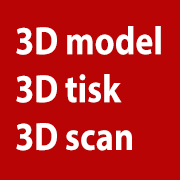
Reklama
3D tiskárny



AONN.cz
Sp┼Ö├ítelen├ę Weby
|
3D modely ARTDiscobolus at The British Museum, London

The Discobolus of Myron ("discus thrower") is a Greek sculpture that was completed towards the end of the Severe period, circa 460-450 BC. The original Greek bronze is lost but the work is known through numerous Roman copies, both, full-scale ones in marble, which was cheaper than bronze, such as the first to be recovered, the Palombara Discobolus, or smaller scaled versions in bronze. A discus thrower is depicted about to release his throw: "by sheer intelligence", Kenneth Clark observed in The Nude, "Myron has created the enduring pattern of athletic energy. He has taken a moment of action so transitory that students of athletics still debate if it is feasible, and he has given it the completeness of a cameo." The moment thus captured in the statue is an example of rhythmos, harmony and balance. Myron is often credited with being the first sculptor to master this style. Naturally, as always in Greek athletics, the Discobolus is completely nude. His pose is said to be unnatural to a human, and today considered a rather inefficient way to throw the discus. Also there is very little emotion shown in the discus thrower's face, and "to a modern eye, it may seem that Myron's desire for perfection has made him suppress too rigorously the sense of strain in the individual muscles," Clark observes. The other trademark of Myron embodied in this sculpture is how well the body is proportioned, the symmetria. The potential energy expressed in this sculpture's tightly-wound pose, expressing the moment of stasis just before the release, is an example of the advancement of Classical sculpture from Archaic. The torso shows no muscular strain, however, even though the limbs are outflung. After the discovery of the Discobolus Palombara a second notableDiscobolus was excavated, at Hadrian's Villa in 1790, and was purchased by the English antiquary and art dealer established in Rome, Thomas Jenkins, at public auction in 1792. (Another example, also found at Tivoli at this date, was acquired by the Vatican Museums.) The English connoisseur Charles Townley paid Jenkins £400 for the statue, which arrived at the semi-public gallery Townley commissioned in Park Street, London, in 1794. The head was wrongly restored, as Richard Payne Knight soon pointed out, but Townley was convinced his was the original and better copy. This marble statue is one of several copies of a lost bronze original of the fifth century BC which was attributed to the sculptor Myron (flourished about 470-440 BC). The head on this figure has been wrongly restored, and should be turned to look towards the discus. The popularity of the sculpture in antiquity was no doubt due to its representation of the athletic ideal. Discus-throwing was the first element in the pentathlon, and while pentathletes were in some ways considered inferior to those athletes who excelled at a particular sport, their physical appearance was much admired. This was because no one particular set of muscles was over-developed, with the result that their proportions were harmonious. A number of ancient discuses of either marble or metal, and of various weights, survive. Little is known of the distances achieved in antiquity, though an epigram celebrating a throw of 30 metres (95 feet) comes as a surprise in the modern world, where the current world record is just over 70 metres. However, the ancient technique of discus-throwing may have been rather different: there is no representational evidence for anything more than a three-quarter turn, rather than the two and a half turns used today, and this may be one factor making a direct comparison difficult. n├íhodn├Ż v├Żb─Ťr model┼»
|
©Ofrii 2012
| |||